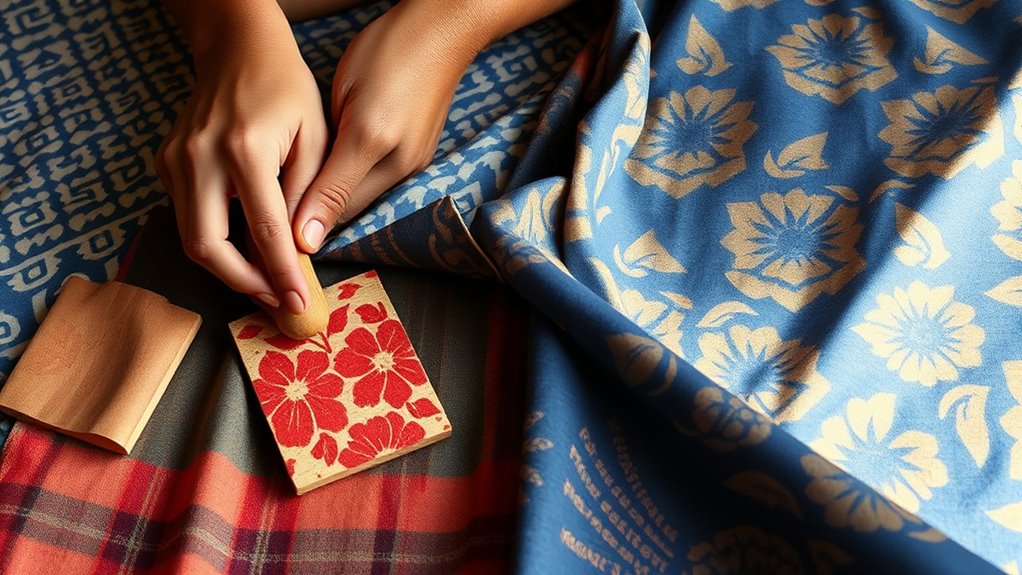Artisan textiles like ikat, block print, and batik showcase centuries-old techniques that blend craftsmanship, cultural heritage, and intricate design. With ikat, yarns are dyed before weaving to create blurred, shimmering patterns, while block printing uses carved wooden blocks to apply bold, repeating motifs on fabric. Batik involves applying wax as a resist before dyeing, producing detailed, layered patterns. If you’re curious about how these ancient methods shape vibrant textiles, keep exploring these fascinating techniques.
Key Takeaways
- Ikat involves dyeing yarns before weaving to create blurred, feathered patterns with depth and shimmer.
- Block printing uses carved wooden blocks to manually apply dye, producing consistent, bold motifs and geometric designs.
- Batik employs wax as a resist, layering wax and dye to craft intricate, detailed patterns with cultural significance.
- These techniques reflect rich craftsmanship, cultural heritage, and traditional methods passed down through generations.
- Natural dyes and meticulous processes ensure vibrant, authentic textiles with unique textures and visual appeal.

Have you ever wondered how traditional techniques create the rich textures and vibrant patterns of artisan textiles? It all starts with the mastery of weaving techniques and the skillful use of dyed fabrics. These methods have been passed down through generations, each adding its unique touch to the creation of stunning textiles. When you observe artisan fabrics, you’re witnessing a blend of history, craftsmanship, and cultural identity woven into every thread. The intricate weaving techniques form the backbone of these textiles, providing structure and durability, while the dyed fabrics bring color and life to each piece. The dyes, often derived from natural sources, are carefully applied through processes like resist dyeing, which ensures the patterns remain vivid and sharp. Natural dyes play a crucial role in maintaining the authenticity and vibrancy of these textiles. Take ikat, for example. This technique involves dyeing the yarns before they’re woven into fabric, creating a blurred, feathered pattern that’s uniquely mesmerizing. You’ll notice that the design appears as if it’s floating on the fabric’s surface, a result of meticulously tying and dyeing the yarns in specific sections. The process demands precision and patience, as each color change requires re-tieing and re-dyeing the yarns. When woven, these dyed yarns produce intricate, symmetrical patterns that seem to shimmer with depth. The beauty of ikat lies in its complexity, where every pattern is a tribute to the artisan’s skill and careful planning. In contrast, block printing involves applying dye to fabric using carved wooden blocks. Here, the focus is on the manual stamping process, which allows artisans to create repeating patterns with remarkable consistency. The dyed fabrics used in block printing often feature bold motifs and geometric designs, achieved through a precise application of dye and block placement. The tactile quality of these textiles adds to their charm, as each print embodies the artisan’s craftsmanship and attention to detail. The process combines the visual appeal of vibrant colors with the tactile richness of textured fabrics, making each piece a work of art. Batik, another traditional technique, uses wax as a resist to create intricate patterns. You dip a brush or canting tool into hot wax and draw detailed designs onto the fabric. When the fabric is dyed, the wax resists the dye, leaving the pattern untouched. As the wax is removed, vibrant colors emerge against the background, revealing complex, often symbolic patterns. The process involves multiple layers of wax and dye, each adding depth and complexity to the textile. The combination of wax resist and dyeing produces textiles that are not only visually stunning but also rich in cultural significance.
Frequently Asked Questions
How Do Artisans Ensure Colorfastness in Traditional Textile Dyes?
You guarantee colorfastness by using natural mordants that help fix the dye to the fabric, preventing fading. Artisans typically pre-treat textiles with these mordants, such as alum or tannin, to improve dye fixation. They also carefully control dyeing conditions like temperature and duration, ensuring the colors penetrate deeply. This process results in vibrant, durable textiles that retain their color through washing and everyday use.
What Are the Regional Variations in Ikat Patterns Across Countries?
A stitch in time saves nine, they say, and the same applies to understanding ikat patterns. You’ll notice regional motifs and cultural influences shape distinct styles across countries. In Indonesia, vibrant geometric designs reflect local stories, while in India, intricate motifs mirror spiritual beliefs. Each region’s ikat reveals its unique heritage, making the fabric not just beautiful but a woven narrative of cultural identity.
How Sustainable Are the Dyeing Techniques Used in Batik?
You’ll find that batik dyeing techniques can be quite sustainable when eco-friendly dyes are used and natural pigment sourcing is prioritized. These methods reduce chemical waste and minimize environmental impact. By choosing artisans who focus on natural dyes, you support sustainable practices and help preserve traditional crafts. Overall, batik’s sustainability depends on the dyes and sourcing methods, making it more eco-conscious when natural pigments are at the core.
What Tools Are Essential for Creating Intricate Block Prints?
To create intricate block prints, you need essential tools like printing blocks and dye brushes. Printing blocks are carved with detailed patterns, allowing you to stamp repetitive designs precisely. Dye brushes help you apply colors accurately and smoothly, enhancing the overall detail. Together, these tools enable you to craft complex, beautiful patterns. With steady hands and patience, you turn simple tools into works of art, bringing your textile visions to life.
How Has the Global Market Influenced Traditional Textile Craftsmanship?
You see that the global market pushes traditional textile craftsmanship toward market adaptation, encouraging artisans to balance cultural preservation with commercial appeal. As demand grows worldwide, you might incorporate modern designs or techniques while maintaining authenticity. This dynamic allows you to reach broader audiences, ensuring these rich traditions survive and thrive, even as you adapt to changing tastes and economic pressures, ultimately safeguarding cultural heritage in a competitive global landscape.
Conclusion
You see how artisan textiles like ikat, block print, and batik carry rich cultural stories and craftsmanship. By supporting these crafts, you help preserve centuries-old techniques, like Maya artisans’ intricate batik designs that tell their community’s history. Imagine choosing a hand-printed block fabric for your home; every piece becomes a conversation starter, connecting you to a tradition that’s been passed down through generations. Your appreciation can truly make a difference.









